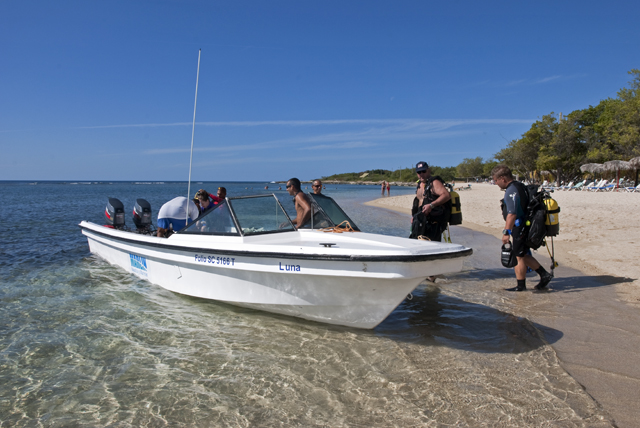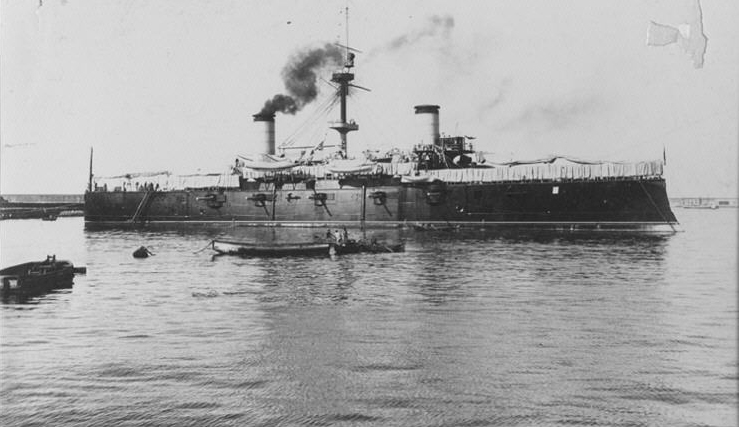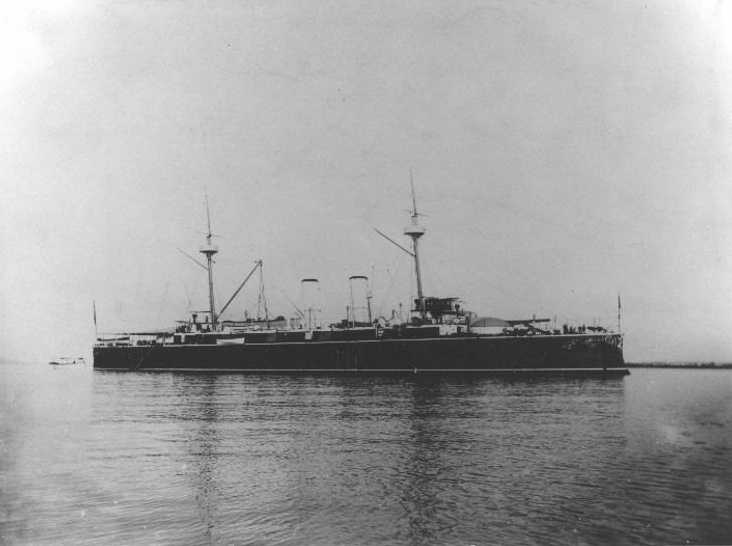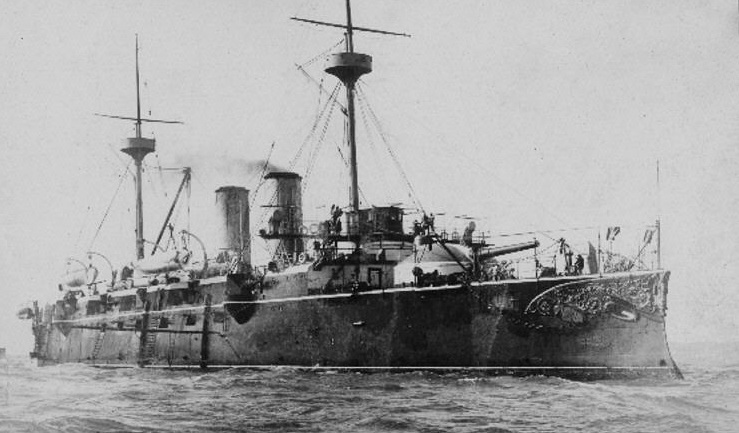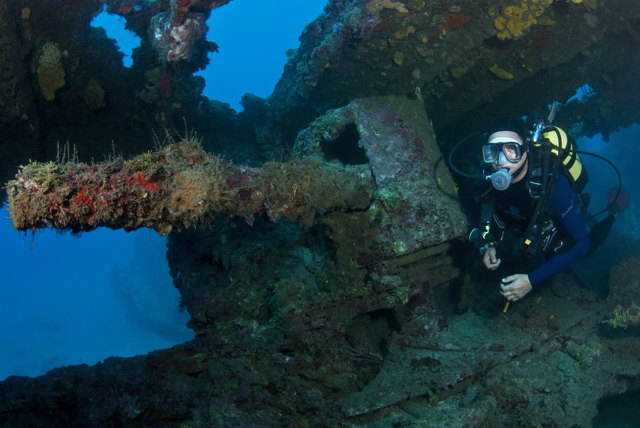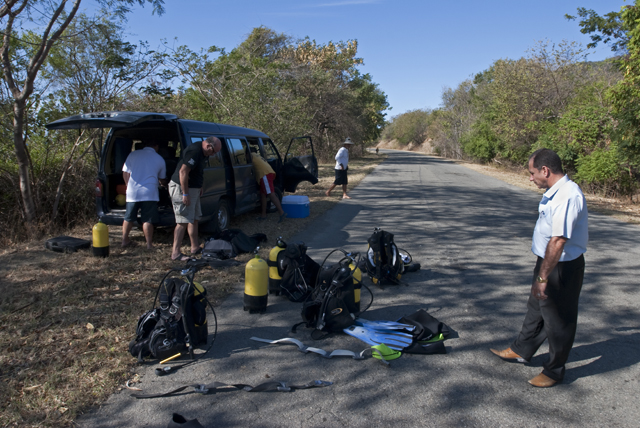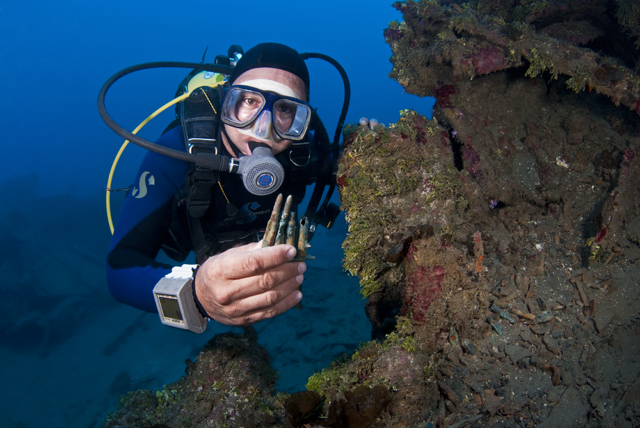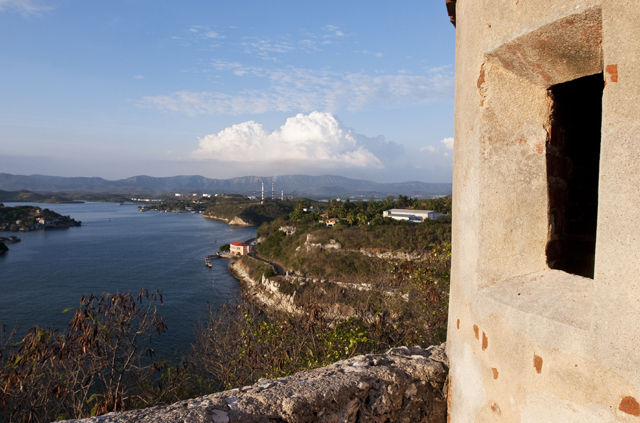News
The wrecks of the Battle of Santiago
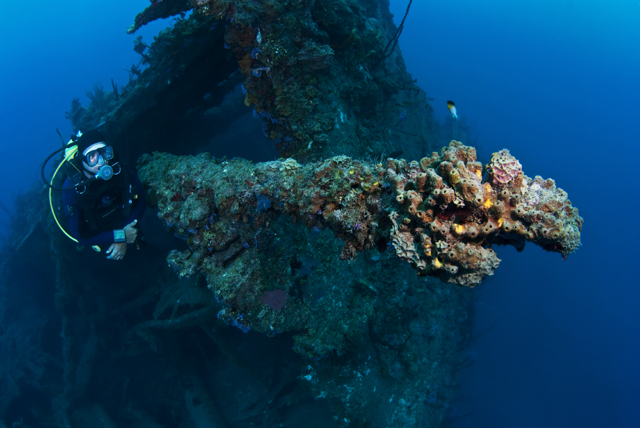
I’m always on the lookout for exciting new wreck dives, but I didn’t expect to find 4 historical warships all sunk in the same sea battle! I had spotted a poster promoting the American-Spanish civil war wrecks on the Cuba Tourism stand at the dive show, but when I investigated further no one seemed to offer any dedicated diving trips and I couldn’t find much information on the internet.
By Cuban standards the great sea battle at Santiago de Cuba was their equivalent to Scapa Flow or Truk Lagoon, so what was the problem? After spending more than a century underwater maybe there just wasn’t anything left to see? I spoke with John Spencer-Ades, the owner of The Scuba Place, and firmed up plans for a full on exploratory expedition just to find out what was actually lying on the seabed.
John contacted Marlin dive centres and they recommended that I stay at Santiago for the first leg of my trip and then transfer up the coast to Guama for the final stages. Unfortunately the whole week turned out to be a fruitless exercise. Most of the wrecks are located near river mouths so the heavy summer rainfall obliterates the sites with murky water. When I spoke to the dive centre manager, Julian Bosch, he recommended a visit during the drier winter months and said he could normally guarantee crystal clear conditions. It was really frustrating to see the huge 11 inch (280mm) guns towering above the waterline and not be able to get any decent underwater pictures. I spent the rest of my time diving on a number of modern day freighters and passenger ferries located to the east of Santiago Bay, but that’s another story.
A few months later I returned with John and his friend Bruce Milani. As before, I based myself at the 5-star Melia Hotel. This was approx 20 minutes drive from the dive centre at Santiago Harbour. I stuck with my original plan to re-trace the entire sea battle starting with the wreck of the Collier Merrimac, located in the middle of Santiago bay.
Admiral Pascual Cervera Y Topete had set sail for the Caribbean with 6 Spanish warships.
Upon hearing this grave news, America mobilised the entire fleet. The North Atlantic Squadron commanded by Rear Admiral William T Sampson and the Flying Squadron commanded by Commodore Winfield Scott Sibley was ordered to hunt down and sink the Spanish warships. Several tense weeks passed by without a single sighting, and then they were spotted lying at anchor in Santiago Bay. Rear Admiral Sampson ordered an immediate blockade of the harbour entrance. Julian said the Americans attempted to stop Cervera’s Squadron from leaving the harbour by blocking the exit. The 98m long US Collier Merrimac was scuttled in the main channel but unfortunately the steering gear was damaged by gunfire and the ship drifted out of position before it sank.
The Merrimac is located just 5 minutes speed boat ride from the dive centre at a maximum depth of 20 metres. It’s only possible to dive the wreck on an incoming tide due to the amount of sediment that comes out of the harbour. The first few metres of the descent are virtually ‘pea soup’ with zero visibility. Due to the wrecks position smack bang in the middle of the harbour entrance there’s also the possibility of overhead boat traffic. Once I got through the ‘fog’ layer visibility increased to around 10-15 metres but the water had a strange fluorescent green tinge and it was still quite dark owing to the overhead silt layer. A torch is essential and some careful finning required owing to the fact that the bottom composition is made up of fine sediment. There also seemed to be a growing population of Lionfish on the wreck.
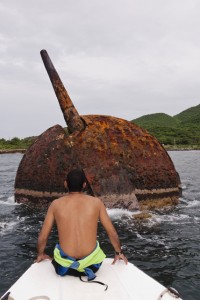
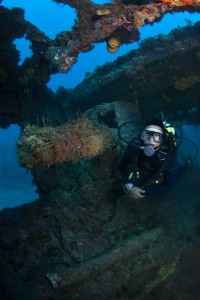 Although most of the topside structure has collapsed there is still plenty to explore. The stern area seems to be more intact with the massive propeller being the main feature. Julian showed me the huge anchor lying half buried in the sand around 10 metres off the starboard side stern. The cargo holds are still full of coal and there are portholes, anchor chains, bollards and winches to look at. I found plenty of small shoals of fish swimming about, and jellyfish are quite common.
Although most of the topside structure has collapsed there is still plenty to explore. The stern area seems to be more intact with the massive propeller being the main feature. Julian showed me the huge anchor lying half buried in the sand around 10 metres off the starboard side stern. The cargo holds are still full of coal and there are portholes, anchor chains, bollards and winches to look at. I found plenty of small shoals of fish swimming about, and jellyfish are quite common.
Although Cervera felt relatively safe holed up inside the harbour the Cuban Government wouldn’t assist with any repair work to his ships. After a 37 day stale-mate Cervera received news that US land forces were rapidly advancing on his position. This left the veteran Admiral only 2 options; either surrender or make a break for it. At 9-00am on Sunday 3rd July 1898, when the Americans were busy with religious services, he gave orders to up anchor and leave the bay.
The ships came out in single file on a westerly heading. Cervera’s flagship, Infanta Maria Teresa was in the lead followed by armed cruisers Cristobal Colon, Almirante Oquendo and Vizcaya. The general idea was to hug the coastline until they got past the American warships and then make a dash for the open sea. Earlier that morning some of the American ships including the flagship USS New York had left position to rendezvous with US land forces. This had left a gap in the blockade line.
Lookouts spotted the Spanish ships and sounded battle stations. Armed Cruiser USS Brooklyn engaged the lead ship Infanta Maria Teresa. Cervera’s brave plan was to draw fire so that the rest of his squadron could escape. The 111m long (7,000 ton) flagship, bombarded by shells, eventually caught fire and ran aground. Most of the crew escaped and swam safely ashore including the Admiral. I’m not quite sure what happened to the wreck of the infant Maria Teresa. Julian said he had found some wreckage close to shore but nothing really substantial. I did find some reference to a salvage operation, so maybe that was the ship’s fate?
Armed Cruiser Almirante Oquendo managed to get slightly further along the coast before receiving a barrage of direct hits from USS Iowa. The stricken ship changed course and was scuttled in the shallows. The wreck is approximately 1 hour speed boat ride from the dive centre. I could see the huge deck guns pointing skywards way before we reached the site. The circular bow turret is almost completely out of the water. The stern turret is submerged and only the barrel breaks the surface. Julian had already warned me that the prevailing cold front would make surface conditions quite choppy but I wasn’t prepared for the same murky conditions underwater, in fact it was slightly worse than the summer time. I finned along the entire length of the hull to the deepest point at about 10 metres but conditions didn’t get any better. Most of the super structure is a mass of twisted metal but I could still identify the massive boilers, a row of port holes and the main mast. I also found plenty of reef fish, morays and lobsters milling about.
Vizcaya had an hour long battle with USS Brooklyn and was reported to have been hit around 200 times. A huge explosion forced the ship inshore where she eventually ran aground. This site is approximately 2.5 hours by speedboat from the dive centre. The bow turret also breaks the surface but this time the aft gun and turret lie upside down on the seabed. Unfortunately the underwater conditions were just as disappointing as the Oquendo. Most of the structure is covered in soft corals making it very difficult to differentiate wreck from reef. I managed to wriggle inside the upturned turret and take a look at the guns firing mechanism but there wasn’t much else to penetrate. For me the best ‘lost’ picture opportunity was the giant turret mounting wheel, which standing vertically, reminded me of a ‘Stargate’. I could picture a diver swimming through the metal ring, torch in hand, but alas it wasn’t to be on this trip.
The 2 Destroyers Pluton and Furer tried to escape by turning east. But they were shelled by USS Iowa, USS Indiana and eventually by USS New York. On receiving news of the battle, Flagship USS New York had turned around and come back. Furor was sunk and Pluton ran aground and blew up. Julian said there was nothing of any significance left to see.
The Cristobal Colon managed to break away from the pursuing American warships. The 112m long (8000 ton) Italian built ship was a new second generation cruiser. With a top speed of 20 knots she was easily the fastest ship in the Spanish squadron. But Captain Emilio Diaz Moreu had a number of concerns. Firstly the ship had been dispatched to Cuba without her full armament. The main 10 inch gun was missing. For show a dummy wooden gun had been fitted to the mounting. Secondly the supply of high grade British coal, fuelling the furnaces, was about to run out. The low quality coal remaining would not allow them to maintain their current speed. This meant that the US ships would eventually catch them up. USS Oregon managed to fire 2 shots across Colon’s stern. In Captain Moreu’s mind this was far too close for comfort. He gave the order to open the stop cocks and scuttle the ship.
The wreck of the Colon was way beyond the range of Julian’s speedboat. John made arrangements for us to stay at the 3.5-Star Brisas Sierra Mar Hotel located approximately 2 hours (60km’s) taxi-drive from Santiago at a place called Guama. We spent a night at the Hotel and then in the morning travelled another 2 hours by minivan to the shore diving site. I spoke to Edgar, the Hotel’s dive centre manager, before we left and he said ‘there’s a cold front coming’. From past experiences I already knew that this meant another bout of strong winds and unsettled seas. Not ideal conditions for photography or for that matter a shore dive. As we drove along the coast road I could see a coffee coloured ‘dirty water’ slick oozing from the shallows blending with clearer blue water about 200 – 300 metres out to sea. Edgar said not to worry all would be okay but my scepticism was rising fast.
Edgar said that the wreck used to be a popular dive site up until Hurricane Ike struck in September 2008. We edged our way over a concrete bridge that had been decimated by the full force of the storm. It looked more like a scene from an earthquake disaster movie. Edgar said that the long journey had discouraged a lot of divers.
We kitted up by the roadside shaded from the sun by overhanging trees. Edgar disappeared down a steep sided embankment carrying his full diving kit so we all followed suit. I slipped on the muddy slope and ended up going down on my rear end. We broke through the tree line onto a rock and pebble beach. To be honest conditions on the day were marginal at best (2m high waves) but this was the only opportunity I was going to get. We had been bumping and bashing our way over some seriously large potholes for the past 2 hours and I didn’t want to return empty handed.
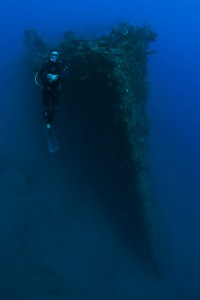
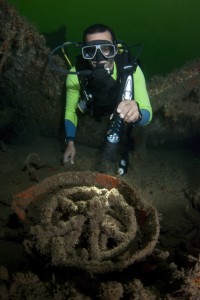 My initial head dunk underwater confirmed my concerns. I could see horizontally about 1 to 2 metres at best. But I should have put more faith in Edgar who had been diving on the wreck for more than 15 years. When we reached a depth of about 6 metres the sediment cloud dispersed leaving clear blue water. I followed Edgar over the stern and down the port side. The ship was facing directly out to sea, which seemed a strange position – I would have thought that Captain Moreu would have run aground bow first. Edgar said that the ship had probably been turned around during salvage attempts.
My initial head dunk underwater confirmed my concerns. I could see horizontally about 1 to 2 metres at best. But I should have put more faith in Edgar who had been diving on the wreck for more than 15 years. When we reached a depth of about 6 metres the sediment cloud dispersed leaving clear blue water. I followed Edgar over the stern and down the port side. The ship was facing directly out to sea, which seemed a strange position – I would have thought that Captain Moreu would have run aground bow first. Edgar said that the ship had probably been turned around during salvage attempts.
Edgar guided me to a hold full of ammunition. The bullets were held in cartridges of 5 or maybe 6. There were literally thousands of brass cases lying about. The tour continued past the funnel and on towards the bow. We stopped by one of the side-mounted 6 inch deck guns covered in coral growth. This ship must have been quite a sight during its heyday. I followed the curvature of the bow down to the seabed at 30 metres. I knelt in the sand (warily watching 3 Lionfish closing in on me) and put my camera lens on the widest possible setting for a picture.
We crossed over to the starboard side where there was a mass of mangled super structure lying on the seabed. Edgar rummaged around in the sand and pulled out a Brass Lantern still pretty much intact. This had obviously been hidden for safe keeping. I’m sure there were plenty of other artefacts waiting to be discovered inside the wreck. I circumnavigated the outside and explored most of the upper deck area. I spotted a number of entry points for some deeper penetration, but unfortunately we ran out of time.
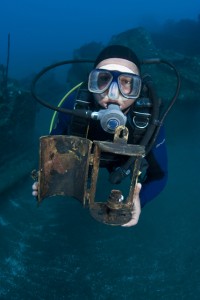
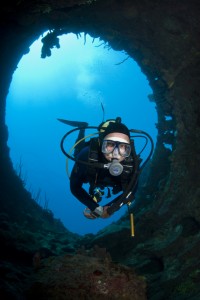 In a matter of hours the Battle of Santiago was over. The Spanish Caribbean Squadron had been completely destroyed. 6 ships had been sunk or scuttled, 474 men were either dead or injured and 1,800 men had been captured. A number of American ships had been damaged, but none were actually sunk, and only 1 US seaman was reported dead.
In a matter of hours the Battle of Santiago was over. The Spanish Caribbean Squadron had been completely destroyed. 6 ships had been sunk or scuttled, 474 men were either dead or injured and 1,800 men had been captured. A number of American ships had been damaged, but none were actually sunk, and only 1 US seaman was reported dead.
I’m not sure this trip would be suitable for die-hard wreck fanatics (although combined with the modern day shipwrecks it might work?). They are not that deep and penetration is limited. I would say it’s better suited for divers with some spirit of adventure that like historical wrecks and don’t mind travelling slightly off the beaten track. There are no other divers or dive boats operating in the area.
Before leaving Santiago de Cuba I made a visit to UNESCO site Castillo de San Pedro de la Roca, located at the entrance to Santiago Bay. Looking down from the ramparts I wondered what it must have felt like to see the whole battle raging below. I sat and watched the lowering of the flag ceremony as the sun dipped below the horizon. A Cannon fired a single salvo out to sea marking the end of another memorable day.
News
Book Review: Fire on Monroe Bravo by Fred Lockwood

Fire on Monroe Bravo is the latest book in the Jack Collier series by Fred Lockwood. Our story begins with our lead characters, Jack and Sandro, owners of Marine Salvage & Investigation Company, arriving on the Monroe Bravo Oil & Gas Platform in the North Sea. Having secured a contract for their vessel the MV Stavanger to act as support ship to the platform for TransGlobal Oil, our protagonists are on a celebratory visit.
However almost as soon as they arrive a series of explosions rock the platform, causing huge damage, loss of life and the very real danger of a massive human, ecological and financial disaster.

As the danger mounts for both our heroes and the surviving workers, Jack and Sandro will have to escape the inferno, all while trying to save the platform and the men still trapped unable to help themselves.
The disaster sets the scene for the unfolding story lines following the fate of the platform and our main characters, the police investigation into a suspected terrorist act and the actions of TransGlobal Oil as they attempt to navigate the pubic outcry and financial repercussions.
In his eighth book, Fire on Monroe Bravo, Fred Lockwood delivers an explosive thriller, with plenty of above and in-water drama, and our heroes fighting for survival, what more can you ask for?
We thoroughly recommend this read and look forward to the next in the series. For more information about his book series, you can check out the reviews of his previous books here on Scubaverse.
- Title: Fire On Monroe Bravo
- Author: Fred Lockwood
- ISBN: 979-8325324536
Available in a paperback version and for Kindle from Amazon and book stores.
Blogs
Alonissos: The complete diving destination (Part 1)

In June we were incredibly fortunate to be invited to dive in Alonissos, a small Greek Island in the Sporades island chain located in the North Aegean Sea. While I have long been a big fan of the Greek Islands as a great holiday destination, I had not had the opportunity to do any diving on previous visits and Mike and I were extremely excited to see what Alonissos had to offer both above and below the surface!

The Sporades are easily accessible via the airport in Skiathos (the first island in the chain), which is served by Jet2 flights from all major UK airports from May through October. Numerous ferries and charter boats make island hopping from Skiathos Town a breeze. After an hour boat ride, the picturesque port of Patitiri was a wonderful introduction to Alonissos, where we were met by our gracious hosts Kostas of Albedo Travel and Dias of Alonissos Triton Dive Center. Mike and I were delighted to be staying at the Paradise Hotel, aptly named for its stunning views over the sea and great location for walking to the waterfront.

Alonissos is beautifully situated in the National Marine Park of Alonissos and the Northern Sporades, the largest marine protected area in Europe. The surrounding seas offer fabulous marine life, including incredibly rare species such as the Mediterranean monk seal. They boast deep walls covered in gorgonians and sponges, stunning topography with caverns, swimthroughs and pinnacles, and the first accessible ancient shipwreck from 500BC!

In locations where historical sites have been reported, the waters are largely restricted, but with collaboration between government, underwater archeologists and dive centres, incredible underwater museums are being created for a truly unique diving experience. Alonissos is home to the first of these, the Ancient Shipwreck of Peristera Accessible Underwater Archeological Site. The chance to dive into history (along with reports of healthy reef life and amazing underwater topography) meant Mike and I were keen to get in the water.

Our introduction to the diving around Alonissos was at the Agios Georgios Pinnacles, in the channel between Alonissos and Skopelos. This fantastic site was named “The Chimney,’ and proved to have a huge amount to see. We got to a decent depth here (over 25m), and marvelled at a colourful reef wall with a wonderful swim through whose rocky walls were absolutely covered with life. As well as brilliant topography there was no shortage of macro life here. We saw numerous nudibranchs, five different species in total. The second dive at Mourtias reef nearby was a shallower dive along a nice wall with lots of crevices. Several moray eels and grouper called this site home. We enjoyed looking in the crevices for lobster and smaller benthic life, such as cup corals and tunicates.

Our itinerary allowed us two dives a day with afternoons left to explore the island with our hire car and evenings to enjoy the famous Greek hospitality. This proved to be a lovely mix of in-water and land based diversions.

The next days diving to the Gorgonian Gardens and Triton’s Cave was to be even better! These two stunning sites are nothing short of fabulous. The Gorgonian Gardens was a deep wall near to the Agios Georgios islands. The ever-present currents in this deep channel meant that the sea life was amazing … the namesake Gorgonian sea fans dotted the wall at a depth of 30 to 50 meters, getting ever larger the deeper we went. Above 30m was by no means less beautiful, with sponges, corals, scorpionfish, moray eels and some rare and colourful nudibranchs.

The second shallower dive of the day was to Triton’s Cave or the Cavern of Skopelos, on the east side of that island. The spectacular rock formations had wild striations both above and below the water making a truly epic topography. The cavern entrance was at 14m, and big enough for a buddy pair, winding up to 6m and passing two beautiful windows out into the blue. Emerging from the cavern, the light at the shallower depths and the incredible rock formations made for a fantastic gentle swimming safety stop and we all surfaced by the boat with massive grins.

Check out our next blog :Alonissos: The complete diving destination (Part 2)” to hear about our amazing dive on the 2500 year old Peristera Wreck!
Thanks to:
Alonissos Triton Dive Center https://bestdivingingreece.com/
Albedo Travel https://alonissosholidays.com/activities/
Paradise Hotel https://paradise-hotel.gr/
Alonissos Municipality https://alonissos.gr/en/
-

 Blogs2 months ago
Blogs2 months agoDiving With… Nico, Ocean Earth Travels, Indonesia
-

 News1 month ago
News1 month agoMurex Bangka Announce New Oceanfront Cottages & Beachfront Dining
-

 Blogs2 months ago
Blogs2 months agoA new idea in freediving from RAID
-

 Marine Life & Conservation1 month ago
Marine Life & Conservation1 month agoIceland issue millionaire whale hunter a licence to murder 128 vulnerable fin whales
-

 Marine Life & Conservation2 months ago
Marine Life & Conservation2 months agoThe Shark Trust Great Shark Snapshot is back
-

 News3 months ago
News3 months agoCharting New Waters; NovoScuba Goes Global with the Launch of their Revolutionary Dive Training Agency!
-

 Gear News1 month ago
Gear News1 month agoNew Suunto Ocean – a dive computer and GPS sports watch in one for adventures below and above the surface
-

 Marine Life & Conservation Blogs2 months ago
Marine Life & Conservation Blogs2 months agoBook Review: Plankton



